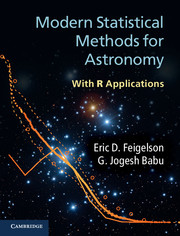Book contents
- Frontmatter
- Contents
- Preface
- 1 Introduction
- 2 Probability
- 3 Statistical inference
- 4 Probability distribution functions
- 5 Nonparametric statistics
- 6 Data smoothing: density estimation
- 7 Regression
- 8 Multivariate analysis
- 9 Clustering, classification and data mining
- 10 Nondetections: censored and truncated data
- 11 Time series analysis
- 12 Spatial point processes
- Appendix A Notation and acronyms
- Appendix B Getting started with R
- Appendix C Astronomical datasets
- References
- Subject index
- R and CRAN commands
- Plate section
11 - Time series analysis
Published online by Cambridge University Press: 05 November 2012
- Frontmatter
- Contents
- Preface
- 1 Introduction
- 2 Probability
- 3 Statistical inference
- 4 Probability distribution functions
- 5 Nonparametric statistics
- 6 Data smoothing: density estimation
- 7 Regression
- 8 Multivariate analysis
- 9 Clustering, classification and data mining
- 10 Nondetections: censored and truncated data
- 11 Time series analysis
- 12 Spatial point processes
- Appendix A Notation and acronyms
- Appendix B Getting started with R
- Appendix C Astronomical datasets
- References
- Subject index
- R and CRAN commands
- Plate section
Summary
The astronomical context
Time-domain astronomy is a newly recognized field devoted to the study of variable phenomena in celestial objects. They arise from three basic causes. First, as is evident from observation of the Sun's surface, the rotation of celestial bodies produces periodic variations in their appearance. This effect can be dramatic in cases such as beamed emission from rapidly rotating neutron stars (pulsars).
Second, as is evident from observation of Solar System planets and moons, celestial bodies move about each other in periodic orbits. Orbital motions cause periodic variations in Doppler shifts and, when eclipses are seen, in brightness. One could say that the birth of modern time series analysis dates back to Tycho Brahe's accurate measurement of planetary positions and Johannes Kepler's nonlinear models of their behavior.
Third, though less evident from naked eye observations, intrinsic variations can occur in the luminous output of various bodies due to pulsations, explosions and ejections, and accretion of gas from the environment. The high-energy X-ray and gamma-ray sky is particularly replete with highly variable sources. Classes of variable objects include flares from magnetically active stars, pulsating stars in the instability strip, accretion variations from cataclysmic variable and X-ray binary systems, explosions seen as supernovae and gamma-ray bursts, accretion variations in active galactic nuclei (e.g. Seyfert galaxies and quasi-stellar objects, quasars and blazars), and the hopeful detection of gravitational wave signals. A significant fraction of all empirical astronomical studies concerns variable phenomena; see the review by Feigelson (1997) and the symposium New Horizons in Time Domain Astronomy (Griffin et al. 2012).
Information
- Type
- Chapter
- Information
- Modern Statistical Methods for AstronomyWith R Applications, pp. 292 - 336Publisher: Cambridge University PressPrint publication year: 2012
